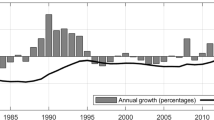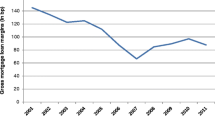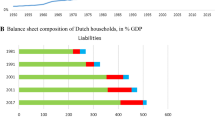Abstract
This paper measures the impact of three types of defaulter-friendly foreclosure laws on the behaviors of mortgage lenders in loan origination, and borrowers in default decision. To disentangle the “pure” influence of foreclosure laws from that of unobserved regional factors, we use the border identification strategy to sort the loan sample in the zip codes on both sides of a border dividing states by the foreclosure laws adopted. Unlike the previous research, we find no conclusive evidence on the causal effects of foreclosure laws on loan supply and default risk. The empirical results are highly sensitive to fixed effect specifications, time period, and sample selection.
Similar content being viewed by others
Notes
Agarwal et al. (2003) look at the effects of exemption law on consumer bankruptcy; Agarwal et al. (2005) focus on the impact of state exemption laws on small business bankruptcy. Their regression models of consumer/small business finance situation on state exemption laws do not control for regional factors (include only unemployment rate).
Deficiency judgment grants lenders stronger bargaining power to extract concessions from borrowers in delinquency.
Foreclosure laws changed over time. Table 1 shows the foreclosure during our sample period 1999–2012. For example, Hawaii moved away from a power of sale state to a judicial foreclosure requirement state from the end of 2012. We thank the suggestions from anonymous referee.
Collins et al. (2011) investigate the impact of foreclosure laws on loan outcomes using the MSA-level loan data covering 22 MSAs in the US. Mian et al. (2014) and Gerardi et al. (2013) use the 10-mile zip code border shared by states as the border identification strategy to delineate states with different foreclosure laws.
Lenders can also charge different fees or set different interests with different law environments. Our paper focuses on the loan supply. We thank the suggestions from anonymous referee.
Details describing loan selection criteria and data overview are documented by Freddie Mac in “Single Family Loan-Level Dataset: General User Guide”.
Adjustable Rate Mortgages (ARMs), initial interest, balloons, any mortgages with step rates, Relief Refinance Mortgages, Federal Housing Administration/Veterans Affairs (FHA/VA) Guaranteed Rural Housing (GRH), and HUD-Guaranteed Native-American mortgages (Section 184) are excluded. First, we consider only fixed rate mortgages to keep interest rate risks relatively exogenous in the models. Second, the government sponsored mortgages often enjoy special exemptions or concessions, (for example, deficiency judgments are prohibited on FHA loans and strongly discouraged on VA loans). The inclusion of exotic loans, and/or loans with concessionary terms could further distort the results, and could create more endogeneity to the empirical results.
The Freddie Mac data report only the first three digits of the five-digit postal code of the mortgaged property. Therefore, we refer the zip codes hereinafter in this paper to the three-digit zip codes.
Our paper focuses on impact of foreclosure laws under different market environments. The credit market has significantly changed after 2008, especially when Lehman Brother collapsed on September 15, 2008, followed by Freddie and Fannie go into the conservatorship of soon after that. We thank the suggestions from anonymous referee.
The 90-day delinquent measure is commonly used to identify loan default (see e.g., Quercia et al. 2014 and Agarwal et al. 2012). A default threshold based on 60-day delinquent has also been used as an alternative default measure in the prior research (Keys et al. 2009; Keys et al. 2010; Jiang et al. 2014; Conklin 2017). We use both default measures in our study, and the results remain largely unchanged.
The aggregate loan observations in the three foreclosure states are 3,713,934 (judicial states), 8,814,319 (right of redemption states), 5,415,778 (“non-recourse states), respectively, and the aggregate nationwide sample is 15,626,550.
Appendix 3 presents detailed description for each sample.
Loans with borrower’s FICO score lower than 500 are excluded.
The calculation details (standards) are documented in Single Family Loan-Level Dataset: General User Guide by Freddie Mac.
A borrower is defined as a first-time homebuyer, if he (she) is an individual who purchases and resides in a mortgaged property as a primary residence, and has no ownership interest (sole or joint) in another residential property during the three-year period preceding the date of the purchase of the mortgaged property (See Single Family Loan-Level Dataset: General User Guide by Freddie Mac).
Further information of the calculation of default option is presented in Appendix 2.
There are 3,546,396, 7,294,756, 4,613,248, and 12,317,399 loan-month observations in the “judicial” sample, the “right of redemption” sample, the “non-recourse” sample, and the nationwide sample, respectively.
State-level foreclosure days are included in the judicial process analyses.
The empirical results in the judicial analyses (unreported) show that foreclosure days do not affect borrower’s default decisions.
References
Adelino, M., Schoar, A., & Severino, F. (2016). Loan originations and defaults in the mortgage crisis: the role of the middle class. Review of Financial Studies, 29(7), 1635–1670.
Agarwal, S., Liu, C., & Mielnicki, L. (2003). Exemption laws and consumer delinquency and bankruptcy behavior: an empirical analysis of credit card data. Quarterly Review of Economics and Finance, 43, 273–289.
Agarwal, S., Souphala, C., Liu, C., & Mielnicki, L. (2005). Impact of state exemption laws on small business bankruptcy decision. Southern Economic Journal, 71(3), 620–635.
Agarwal, S., Ambrose, B. W., Chomsisengphet, S., & Sanders, A. B. (2012). Thy neighbor’s mortgage: Does living in a subprime neighborhood affect one’s probability of default? Real Estate Economics, 40(1), 1–22.
Alston, L. J. (1984). Farm foreclosure moratorium legislation: a lesson from the past. American Economic Review, 74(3), 445–457.
Ambrose, B. W., Buttimer Jr., R. J., & Capone, C. A. (1997). Pricing mortgage default and foreclosure delay. Journal of Money, Credit and Banking, 29(3), 314–325.
Ambrose, B. W., Capone Jr., C. A., & Deng, Y. (2001). Optimal put exercise: an empirical examination of conditions for mortgage foreclosure. Journal of Real Estate Finance and Economics, 23(2), 213–234.
Bradley, M. G., Cutts, A. C., & Liu, W. (2015). Strategic mortgage default: The effect of neighborhood factors. Real Estate Economics, 43(2), 271–299.
Chen, J., & Deng, Y. (2013). Commercial mortgage workout strategy and conditional default probability: Evidence from special serviced CMBS loans. Journal of Real Estate Finance and Economics, 46(4), 609–632.
Clapp, J. M., Deng, Y., & An, X. (2006). Unobserved heterogeneity in models of competing mortgage termination risks. Real Estate Economics, 34(2), 243–273.
Clauretie, T. M. (1987). The impact of interstate foreclosure cost differences and the value of mortgages on default rates. AREUEA Journal: Journal of the American Real Estate & Urban Economics Association, 15(3), 152–167.
Clauretie, T. M., & Herzog, T. (1990). The effect of state foreclosure laws on loan losses: evidence from the mortgage insurance industry. Journal of Money, Credit & Banking, 22(2), 221–233.
Collins, J. M., Lam, K., & Herbert, C. E. (2011). State mortgage foreclosure policies and lender interventions: impacts on borrower behavior in default. Journal of Policy Analysis and Management, 30(2), 216–232.
Conklin, J. N. (2017). Financial literacy, broker–borrower interaction and mortgage default. Real Estate Economics, 45(2), 376–414.
Cox, D. R. (1972). Regression models and life-tables. Journal of the Royal Statistical Society. Series B (Methodological), 34(2), 187–220.
Cox, D. R. (1975). Partial likelihood. Biometrika, 62(2), 269–276.
Cutts, A. C., & Merrill, W. A. (2008). Interventions in mortgage default policies and practices to prevent home loss and lower costs. Freddie Mac Working Paper, #08–01.
Deng, Y. (1997). Mortgage termination: an empirical hazard model with a stochastic term structure. Journal of Real Estate Finance and Economics, 14(3), 309–331.
Deng, Y., Quigley, J. M., & Van Order, R. (1996). Mortgage default and low downpayment loans: The costs of public subsidy. Regional Science and Urban Economics, 26(3–4), 263–285.
Deng, Y., Quigley, J. M., & Van Order, R. (2000). Mortgage terminations, heterogeneity and the exercise of mortgage options. Econometrica, 68(2), 275–307.
Foote, C., Gerardi, K., Goette, L., & Willen, P. (2010). Reducing foreclosures: No easy answers. NBER Macroeconomics Annual, 24(1), 89–138.
Gerardi, K., Lambie-Hanson, L., & Willen, P. S. (2013). Do borrower rights improve borrower outcomes? Evidence from the foreclosure process. Journal of Urban Economics, 73(1), 1–17.
Ghent, A. C., & Kudlyak, M. (2011). Recourse and residential mortgage default: Evidence from US States. Review of Financial Studies, 24(9), 3139–3186.
Gormley, T. A., & Matsa, D. A. (2014). Common errors: How to (and not to) control for unobserved heterogeneity. Review of Financial Studies, 27(2), 617–661.
Guiso, L., Sapienza, P., & Zingales, L. (2013). The determinants of attitudes toward strategic default on mortgages. The Journal of Finance, 68(4), 1473–1515.
Holmes, T. J. (1998). The effect of state policies on the location of manufacturing: evidence from state borders. Journal of Political Economy, 106(4), 667–705.
Jiang, W., Nelson, A. A., & Vytlacil, E. (2014). Securitization and loan performance: ex ante and ex post relations in the mortgage market. Review of Financial Studies, 27(2), 454–483.
Keys, B. J., Mukherjee, T., Seru, A., & Vig, V. (2009). Financial regulation and securitization: Evidence from subprime loans. Journal of Monetary Economics, 56(5), 700–720.
Keys, B. J., Mukherjee, T., Seru, A., & Vig, V. (2010). Did securitization lead to lax screening? Evidence from subprime loans. Quarterly Journal of Economics, 125(1), 307–362.
Keys, B. J., Mukherjee, T., Seru, A., & Vig, V. (2012). Lender screening and the role of securitization: Evidence from prime and subprime mortgage markets. The Review of Financial Studies, 25(7), 2071–2108.
Lin, E. Y., & White, M. J. (2001). Bankruptcy and the market for mortgage and home improvement loans. Journal of Urban Economics, 50(1), 138–162.
Mian, A., Sufi ,A., & Trebbi, F. (2014). Foreclosures, house prices, and the real economy. Kreisman Working Paper Series in Housing Law and Policy working paper, No.6.
Pence, K. M. (2006). Foreclosing on opportunity: state laws and mortgage credit. Review of Economics and Statistics, 88(1), 177–182.
Pennington-Cross, A. (2006). The value of foreclosed property. Journal of Real Estate Research, 28(2), 193–214.
Quercia, R. G., Pennington-Cross, A., & Tian, C. Y. (2016). Differential impacts of structural and cyclical unemployment on mortgage default and prepayment. Journal of Real Estate Finance and Economics, 53(3), 346–367.
Seiler, M. J. (2014). Understanding the far-reaching societal impact of strategic mortgage default. Journal of Real Estate Literature, 22(2), 205–214.
Seiler, M. J., Vicky, L. S., Lane, M. A., & Harrison, D. M. (2012). Fear, shame and guilt: economic and behavioral motivations for strategic default. Real Estate Economics, 40(S1), S199–S233.
Wilkinson-Ryan, T. (2011). Breaching the mortgage contract: the behavioral economics of strategic default. Vanderbilt Law Review, 64(5), 1547–1583.
Acknowledgements
We are grateful to Sumit Agarwal, Brent Ambrose, Yongheng Deng, and the anonymous referees for their valuable comments. All errors are ours. Daxuan Zhao acknowledges the financial support of the National Science Foundation of China (71704182).
Author information
Authors and Affiliations
Corresponding author
Appendices
Appendix 1. Timeline for Foreclosure by State
Appendix 2. The Calculation of Default Option
We strictly follow Ghent and Kudlyak (2011) in computing the default option.
For each loan i with age k (in months) at time t,
where Φ(∙) is the cumulative standard normal distribution.
Appendix 3. Sample Descriptions
Rights and permissions
About this article
Cite this article
Zhao, D., Wang, Y. & Sing, T.F. Impact of Foreclosure Laws on Mortgage Loan Supply and Performance. J Real Estate Finan Econ 58, 159–200 (2019). https://doi.org/10.1007/s11146-017-9641-0
Published:
Issue Date:
DOI: https://doi.org/10.1007/s11146-017-9641-0




